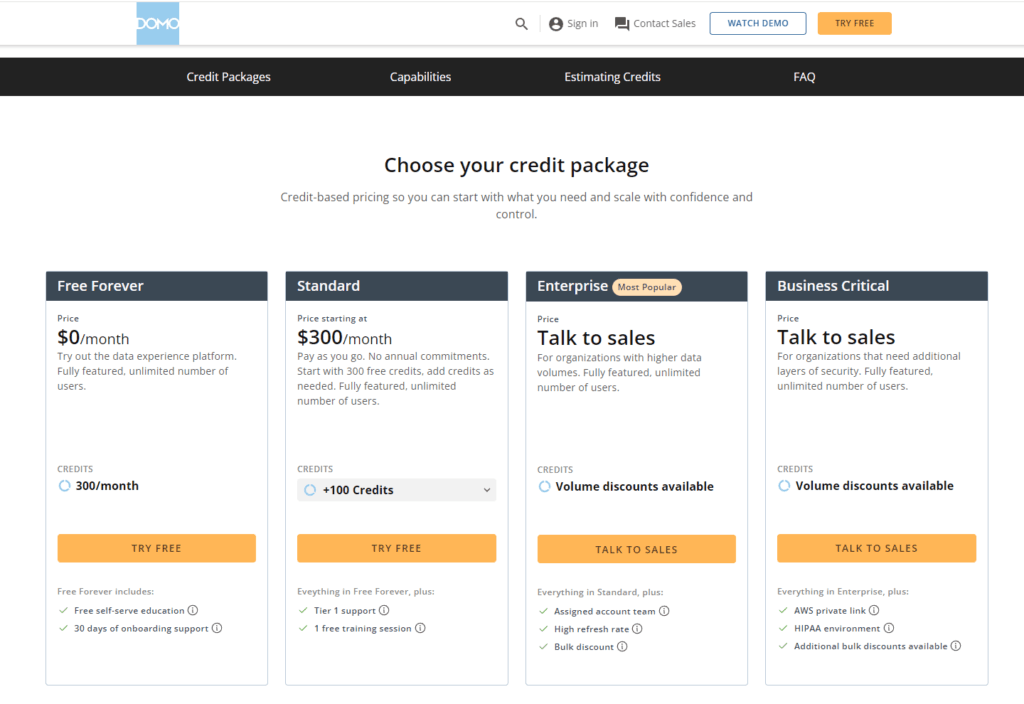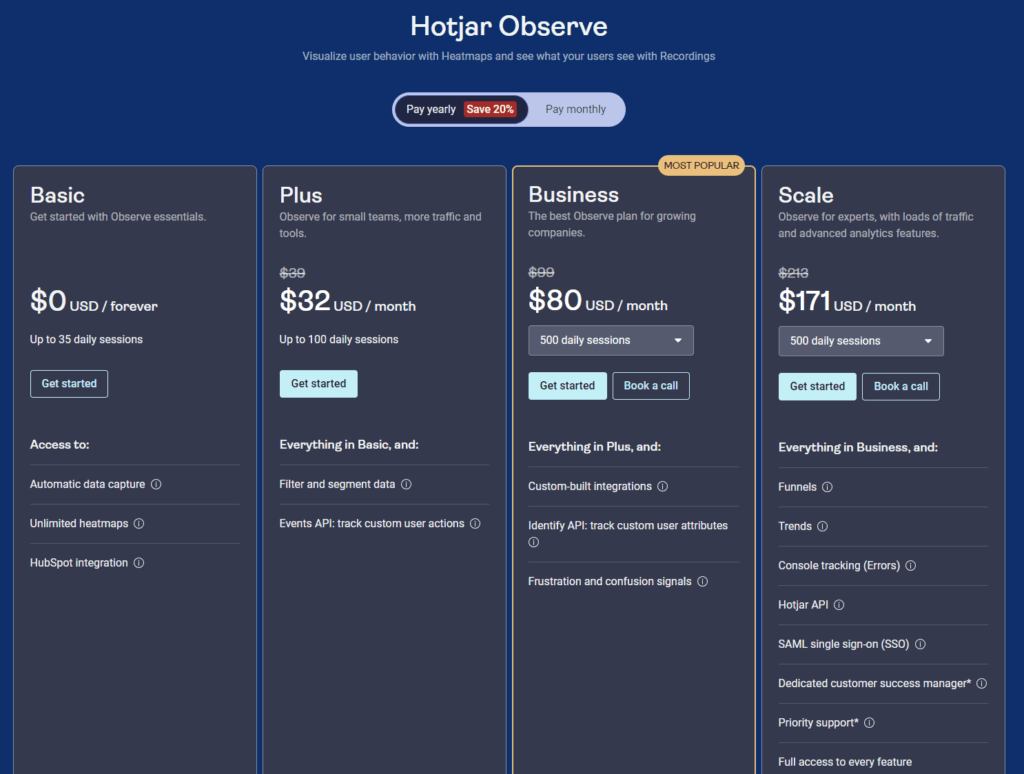In the bustling digital marketplace, understanding how users interact with your online presence is akin to finding treasure in the vast ocean of the internet. It’s not just about attracting visitors; it’s about engaging them, understanding their journey, and optimizing their experience to foster conversions and loyalty. Herein lies the quest to choose the right analytics tool—a beacon to guide you through the murky waters of data towards insightful shores. Domo and Hotjar stand out as leading compasses, each with its unique strengths. But which one will navigate you to success? Let’s dive into their capabilities, starting with their approaches to user experience and behavior analysis.
| Domo | Hotjar |
|---|---|
 |  |
| G2 Score – 4.4 out of 5 stars | G2 Score – 4.3 out of 5 stars |
| TrustRadius Score – 8.5/10 | TrustRadius Score – 8.2/10 |
User Experience and Behavior Analysis
The path to enhancing your digital platform lies in understanding how users interact with it. Here’s how Domo and Hotjar equip you with the insights needed to chart this journey.
Domo: Broad Data Integration for Comprehensive Insights
Domo’s approach to user experience and behavior analysis is through the lens of integrated business intelligence. While Domo itself does not specialize in granular user behavior tracking like heatmaps or session recordings, its power lies in aggregating and analyzing data from a variety of sources to inform on user behavior indirectly. By integrating with tools specifically designed for tracking user interactions, Domo enables businesses to incorporate these insights into a broader data context.
This integration capability allows businesses to view user behavior data alongside other critical business metrics, such as sales performance, marketing campaign results, and operational efficiency. This comprehensive overview enables decision-makers to understand how user interactions on digital platforms correlate with broader business outcomes, facilitating strategic decisions that enhance overall user experience while driving business growth.
The strength of Domo in this area is its ability to unify disparate data sources, providing a macro view of the user experience across multiple touchpoints. This holistic approach is invaluable for businesses looking to optimize the user journey in a way that aligns with larger business objectives.
Hotjar: Specialized Tools for In-Depth User Interaction Insights
Hotjar, in contrast, offers a specialized suite of tools designed explicitly for understanding and improving the user experience on websites and apps. Through features like heatmaps, session recordings, and feedback polls, Hotjar provides a direct window into how users interact with digital properties. This direct feedback loop enables businesses to identify pain points in the user journey, understand what captures users’ attention, and gauge overall satisfaction with the digital experience.
Hotjar’s tools are intuitive and provide immediate, visual insights that are easy to interpret, making it accessible for teams across the organization, from marketing to product development. This ease of use does not sacrifice depth; Hotjar’s capabilities allow for a granular analysis of user behavior, offering detailed insights that can drive targeted improvements to website design, content, and navigation.
The platform also encourages an agile approach to user experience optimization. Rapid testing and iteration based on Hotjar’s insights can significantly enhance the user interface and overall user satisfaction, directly impacting conversion rates and customer loyalty.
Integration Capabilities
The capacity for an analytics tool to integrate with other software defines its ability to serve as a central hub for data-driven insights. Here’s how Domo and Hotjar fare in enabling integrations with other digital tools.
Domo: A Wide-Reaching Digital Ecosystem Connector
Domo’s approach to integration is expansive, reflecting its ambition to serve as the nerve center of an organization’s data strategy. It’s designed to pull in data from a multitude of sources, ranging from cloud-based services and on-premise databases to spreadsheets and social media platforms. This broad spectrum of integration options ensures that businesses can create a holistic view of their operations, customer interactions, and market trends by consolidating disparate data streams into one centralized platform.
The strength of Domo in this area lies not just in the quantity of its integrations but in the depth and flexibility of these connections. Users can leverage Domo’s pre-built connectors, which cover a vast array of popular business tools and systems, minimizing the need for custom development work. For scenarios where bespoke integration is necessary, Domo offers robust APIs and developer tools that allow for the creation of custom data pipelines, ensuring that even the most unique or proprietary systems can be integrated into the Domo environment.
Hotjar: Focused Integrations for Enhanced User Insights
While Hotjar’s integration landscape might appear more focused compared to Domo, it is precisely tailored to enhance its core offering of web analytics and user behavior insights. Hotjar integrates effectively with website and e-commerce platforms, content management systems, and digital marketing tools. These integrations are designed to enrich the user behavior data Hotjar collects, allowing for a more nuanced understanding of how users interact with online content and digital marketing campaigns.
Hotjar’s approach emphasizes ease of use, ensuring that setting up integrations is straightforward and doesn’t require extensive technical expertise. This makes it accessible for marketers, product teams, and UX designers to connect Hotjar with other tools they use daily, enhancing their ability to make informed decisions based on comprehensive user insights. For example, integrating Hotjar with an e-commerce platform can reveal how changes to website design or navigation impact sales and customer engagement, providing actionable feedback for optimization.

Related: Check out our free SEO suite

Customization and Flexibility
The ability to customize dashboards, reports, and analyses, and the flexibility to adapt these tools to changing business needs, can significantly enhance the value derived from an analytics platform. Here’s how Domo and Hotjar accommodate customization and offer flexibility in their services.
Domo: Tailored Insights for Every Need
Domo stands as a beacon for businesses seeking a high degree of customization in their analytics tools. It offers a canvas where data not only can be visualized but also transformed, manipulated, and integrated in ways that align perfectly with specific business requirements. The platform’s architecture is inherently designed to adapt to the evolving needs of businesses, enabling users to create custom dashboards that reflect the unique metrics and KPIs most relevant to their strategic goals. This level of customization extends to Domo’s reporting capabilities, where reports are not just autogenerated documents but carefully crafted narratives that can include a mix of visualizations, text, and layouts chosen by the user.
The flexibility Domo provides is not just about aesthetics; it’s about functionality. Users can tailor the platform to perform complex data operations, from blending data from disparate sources to applying sophisticated analytical models. This ensures that businesses are not just seeing their data but engaging with it in ways that uncover deeper insights and drive actionable strategies.
Hotjar: Streamlined Flexibility for Web Optimization
Hotjar, with its sharp focus on improving website user experience and conversion rates, offers customization and flexibility through a different lens. Its tools are designed to be intuitive and easily adjustable to capture the most relevant user behavior data for any given website or application. Hotjar allows users to customize heatmaps, session recordings, and surveys to target specific elements of a webpage or to ask particular questions that matter most to improving user engagement.
The platform’s flexibility shines in its ability to be quickly deployed on most websites and its straightforward setup for tracking user interactions. This ease of customization means that digital marketers, UX designers, and product managers can rapidly implement changes to their observation strategies, allowing for agile responses to user feedback and behavior trends.
Reporting Capabilities
The way an analytics platform handles reporting can significantly impact its usability and the actionable insights it provides. Here’s a closer look at the reporting features of Domo and Hotjar.
Domo: Comprehensive and Customizable Reporting
Domo’s reporting capabilities are expansive, designed to cater to the comprehensive needs of businesses across various industries. It offers a wide array of reporting options, from basic visualizations to complex, multi-page reports that can incorporate a variety of data visualizations and layouts. Domo’s strength lies in its ability to generate highly customizable reports that can be tailored to the specific requirements of different stakeholders within an organization.
One of the standout features of Domo’s reporting is the ability to automate report distribution, ensuring that key insights are delivered to decision-makers at regular intervals or as data updates occur. This automation streamlines the communication process, making it easier to keep everyone informed and aligned with the latest data insights.
Moreover, Domo’s reports are interactive, allowing users to drill down into specific data points directly from the report for a deeper analysis. This interactivity enhances the usability of reports, making them not just documents for review but tools for exploration and discovery.
Hotjar: Focused Reporting for Web Performance Insights
Hotjar, with its specialized focus on web analytics and user behavior, offers reporting capabilities that are streamlined but powerful in their context. Its reports primarily revolve around visualizations of user behavior on a website, such as heatmaps, session recordings, and feedback polls. These visual reports are intuitive and easy to understand, making them highly effective for communicating insights about user engagement and areas for improvement on a website.
While Hotjar’s reporting might not offer the same level of customization or complexity as Domo, it excels in providing clear, actionable insights tailored to optimizing web performance. The platform also allows for easy sharing of reports, enabling teams to quickly disseminate findings and collaborate on strategies for enhancing user experience.
Cost and Accessibility
Both Domo and Hotjar cater to different market segments, which is reflected in their pricing structures and the accessibility of their features. Understanding these can help businesses decide which platform aligns best with their financial and operational capacities.
Domo: Premium Solutions at a Premium
Domo is recognized for its comprehensive suite of data integration, analysis, and visualization tools, catering to mid-sized to large enterprises with complex data ecosystems. Reflecting its broad capabilities and enterprise focus, Domo’s pricing model is tailored to the scale and specific needs of larger organizations. It operates on a custom pricing structure, which means potential users must contact Domo directly for a quote. This approach allows Domo to offer packages that match the unique requirements of each business, including the number of users, the volume of data processed, and the level of support required.
While this custom pricing ensures businesses pay for exactly what they need, it may place Domo beyond the reach of smaller businesses or startups with limited budgets. Additionally, Domo’s powerful features and extensive customization options come with a steeper learning curve, necessitating a commitment to training and potentially onboarding assistance to fully leverage the platform.

Hotjar: Accessibility for Businesses of All Sizes
In contrast, Hotjar presents a more accessible entry point for businesses focusing on understanding user behavior on their websites. It offers a transparent pricing model with several tiers, including a limited free plan that allows smaller sites and teams to begin analyzing user interactions immediately. Paid plans are structured based on the volume of data and the level of access to advanced features, such as more extensive session recording capabilities and additional heatmaps.
This clear, tiered pricing makes Hotjar an attractive option for a wide range of businesses, from startups and small enterprises to larger organizations looking to complement their existing analytics tools with Hotjar’s user behavior insights. The platform’s user-friendly interface and focus on key web analytics features mean that teams can quickly adopt and start benefiting from Hotjar without a significant investment in training or setup.

Conclusion
Domo positions itself as a comprehensive business intelligence powerhouse, designed for organizations that demand deep data integration, extensive customization, and detailed analytics across all facets of their operation. Its approach caters to medium to large enterprises seeking a centralized analytics solution capable of digesting complex data ecosystems into actionable business insights. The investment in Domo, both financially and in terms of adoption, is significant but justified for businesses that require its broad and deep analytical prowess.
Hotjar, with its focused lens on user experience and behavior analytics, offers an accessible, intuitive tool for businesses of all sizes aiming to enhance their website’s performance and customer satisfaction. Its transparent pricing and ease of use make it especially appealing to small and medium-sized businesses, startups, or any organization prioritizing direct insights into how users interact with their online platforms. Hotjar bridges the gap between vast data analysis and actionable website optimizations, making it a valuable asset for digital marketers, UX designers, and product managers.
Read Next:
- The Secret Behind Consistency – What Goes On In The Mind of Inconsistent People
- 7 Actionable Tips for Creating Your First College Resume
- The No-Nonsense Guide To Being More Productive
- ADHD, Meditation And Ritalin: How You Can Treat ADHD (My Story)
- 31+ Top Social Media Management tools Compared! (2023)





















Comments are closed.